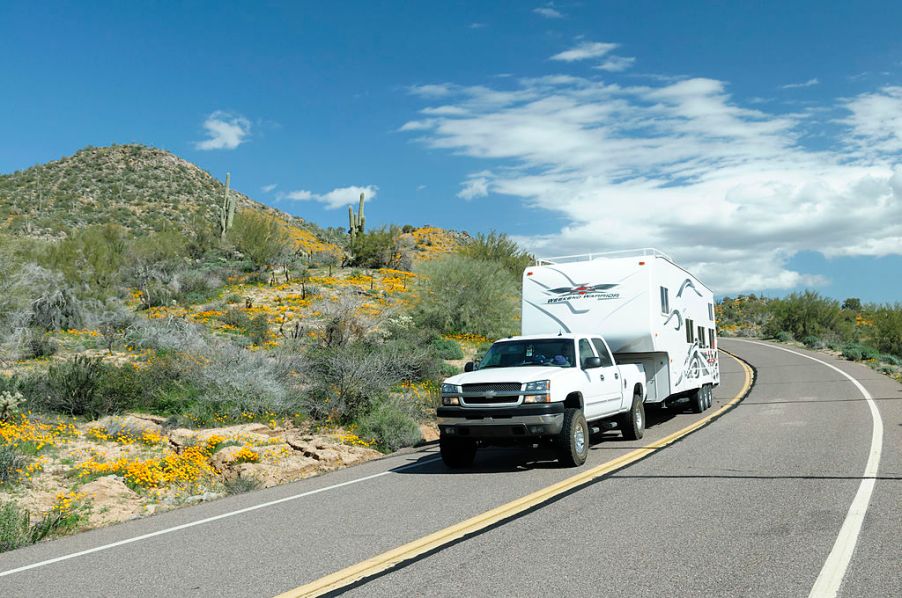
Different Types of Trailer Hitches and Which One Your Truck Should Have
No matter what kind of towing you plan to do, there’s a proper trailer hitch. Because hitches have such a variety, it’s possible that more than one type will do the job. But safety comes first. Make sure you know your hitch class and the size and weight of the load you’ll pull. Double-check the manual of the trailer you’ll tow to confirm its weight capacities.
The hitch you choose also depends on your truck’s trailer hitch setup. And the trailer that does the work will also help determine which hitch is the best choice. Campway and AutoAnything provided us with some helpful information. So, read on to learn more about seven types of trailer hitches.
Receiver hitch (classes 1-5)
The receiver hitch is the most common trailer hitch. Many heavy-duty trucks already come equipped with one in the back. It has a square receiver tube mounted on the truck’s frame. You insert the trailer’s ball mount or another hitch-mount into the tube.
Receivers are organized into classes based on the maximum weight they can handle. Ratings range from Class 1, which can carry weight up to 2,000 pounds to Class 5, which carries a maximum of 12,000 pounds. Also, the tube size varies according to the class, from 1-1/4 inches to 2-1/2 inches.
Bumper-mounted hitch
Instead of being mounted to the truck’s frame like a receiver hitch, this hitch is mounted to the bumper. So, the amount of weight you can tow will be limited by what your bumper can support. Like the receiver hitch, the bumper hitch has a square tube where the trailer hitch-mount is inserted.
Bumper-mounted hitches are simple and versatile. They work well for light loads such as a cargo trailer or smaller camper.
Front-mounted hitch
The front hitch is another variation of the receiver hitch, but it mounts on the truck’s front end. Like the classic receiver hitch, it’s mounted on the frame. As versatile as the receiver hitch, the front hitch can be used for a cargo carrier, a winch, hitch steps, and other applications.
Compared to rear-mounted hitches, the front-mounted hitch allows you to see where you’re going as you back a boat trailer into the water or park a trailer in a small space. Keep in mind, though, that front hitches don’t have the same rating class as rear receivers, so make to know the hitch’s rating before use.
Fifth wheel hitch
In contrast to hitches that mount at the front or rear of the truck, the fifth wheel hitch mounts in the middle of the truck bed, directly over or right in front of the rear axle. Intended to handle huge RV trailers, these hitches’ weight limits can max out between 16,000 and 24,000 pounds. It’s best to double-check the weight limit before you haul, of course.
Besides being limited exclusively for use on heavy-duty pickup trucks, the fifth wheel hitch is unlike other hitches in that the coupling device is part of the hitch and not the trailer’s hitch-mount. Also, fifth wheel hitches are designed to pivot to absorb the road’s bumps and contours.
Gooseneck hitch
Similar to the fifth wheel hitch, the gooseneck mounts in the middle of the truck bed. This hitch is designed to be paired with a gooseneck trailer, which can manage a higher weight capacity.
One advantage of the gooseneck hitch is that it allows a tighter turning radius, which helps if you’re towing a big flatbed or car hauler. Gooseneck hitches also enable you to access the entire truck bed when you aren’t towing.
Weight distribution hitch
A weight distribution hitch mounts to a rear hitch on a truck. Its job is to distribute weight evenly across the tow vehicle and trailer. On this hitch, long rods called spring rods take the weight off the truck’s back and redistributes it toward the trailer. This improves the truck’s steering and keeps the back of the truck from sagging. These hitches are popular for towing campers and horse trailers.
Pintle hitch
The design of the pintle hitch is simple: a hook and a ring made from rugged metal. The mounting of the pintle is located on the frame of large commercial trucks or attached to a mount that inserts into a larger receiver hitch.
Pintle hitches can tow as much as 60,000 pounds. They are used mostly in the agricultural, construction, and military sectors. Drivers of non-commercial trucks don’t often use this hitch because it’s more expensive than other hitches and also because it can be very noisy when on the road.


